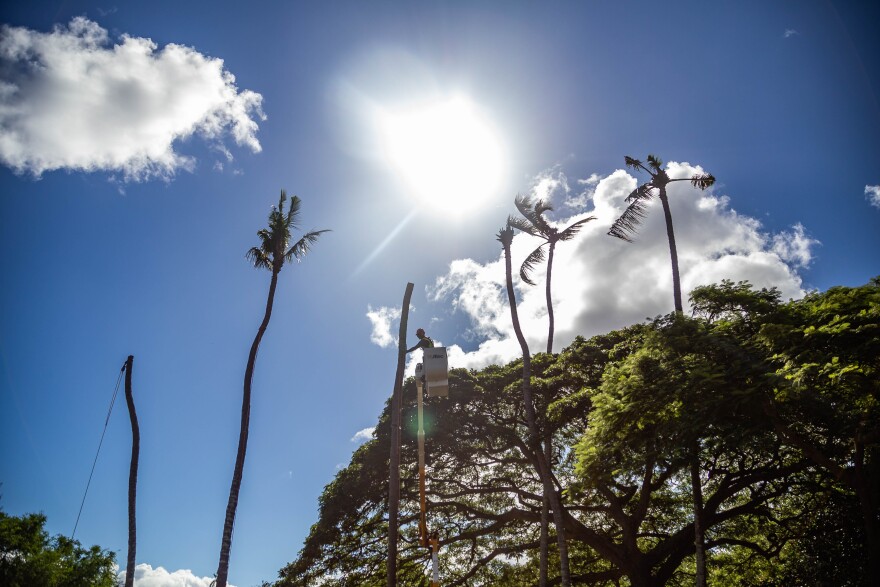The invasive coconut rhinoceros beetle is so widespread on Oʻahu that efforts are focused on containment and management rather than eradication, but the neighbor islands are still fighting to prevent or limit its damage to their communities.
On Molokaʻi, community members are rallying to keep the palm-eating beetle away from the island — the only one where CRB hasn’t been detected.
They’ve signed and submitted a petition to get the state Board of Agriculture and Biosecurity to implement a temporary ban on the import of CRB’s potential breeding material.
The petition has more than 800 signatures as of noon on Tuesday, and was scheduled to be discussed at the board meeting Tuesday morning.
“The idea is to get an interim ruling to continue the vetting of the materials that may be transporting these CRB beetles to all the islands via potting soils and compost and plants that’s coming in from different islands,” said Kunani Nihipali, who spearheaded the petition.
“This is the last bastion on all the islands, and you had 12 years to knock this thing out or do better than what you're doing, and it's still spreading. So, the buck stops here in Molokaʻi.”

The draft rules in the petition would include soil and gravel but exempt preserved plants, plant products meant to be eaten, seeds and cut flowers.
CRB feeds primarily on palm plants like coconut trees, and lives and breeds in green waste. Its spread is often facilitated when humans move that material within and between islands, which is why the petition is calling for an import ban.
The petition comes soon after beetles were found in shipments of plants sent to Lānaʻi, which had also been free of any CRB detection. The beetle has been detected three separate times on the island since May.
But Molokaʻi community members are facing opposition from the Department of Agriculture and Biosecurity.
The state department’s Plant Quarantine Branch, in a draft submittal, agreed that “additional action may be needed” to prevent the beetle from reaching Molokaʻi, but also called the petition’s draft rules "unnecessarily restrictive.”
The petition’s proposed rule is unusual because it bans material that hasn’t been shown to be infested with a pest from being brought to a place that also doesn’t have it.
But the branch said those rules still won’t guarantee that CRB are kept out, and could result in unintended consequences.
“I don't think there's any question that Molokaʻi, as the only island that has never detected CRB, should be protected. I guess the difference is, how do we go about doing that?” said Jonathan Ho, Plant Quarantine Branch manager. “Where it's overly restrictive is, for example, there's no way to move things that have been subjected to treatments that have been scientifically verified to eradicate CRB. It's just a straight-up ban.”
Another concern from the branch is that it would allow a small group of petitioners to ban the movement of items, setting a precedent for others to do the same in the future.
The agriculture board could approve or deny the petition at the Tuesday meeting, but it won’t make a decision on an interim rule.

Meanwhile, the other islands are also trying to stave off CRB infestations
On Hawaiʻi Island, about 80 adult beetles and 200 larvae have been found in the Kona area between two breeding sites discovered near the Ellison Onizuka Kona International Airport.
CRB was first detected on the island in Waikōloa in 2023 and then again last year. In March, it was detected yet again, but in Kona — and since then, it’s been spreading from that area.
Franny Brewer, the program manager for the Big Island Invasive Species Committee, also wants the department to establish a CRB rule for the island. She said a compliance agreement could ensure that potential host material is inspected before moving within or out of an infected area.
“ From what we know, talking to our colleagues throughout the Pacific who've also been dealing with coconut rhinoceros beetles — some of them for decades — movement of material is what everyone identifies as the number one pathway. There's a lot of ways that things can move around, but the number one way that CRB moves around is decomposing material,” Brewer said.
Because the infestation is still manageable in Kona, Brewer said a rule like that could still go a long way to help contain and potentially rid the island of the beetles.
CRB is one of the most notable pests currently spreading through the islands, and most of the state is doing some work to manage the pest.
It first arrived on Oʻahu in 2013, and was contained there for 10 years before it was found on Hawaiʻi Island, Maui and Kauaʻi in 2023.

On Kauaʻi, as of May, 115 beetles have been found in traps — mostly on the east side of the island — according to the Kauaʻi Invasive Species Committee.
On Maui, the last detection was in 2023.
However, on Oʻahu, CRB is considered widespread, though there were recent efforts to protect the population of palm trees in urban Honolulu.
In June, city and state crews injected about 800 palm trees in the Kakaʻako and Ala Moana areas with an insecticide to protect them from the beetle.
Hawaiʻi Public Radio exists to serve all of Hawai’i, and it’s the people of Hawai’i who keep us independent and strong. Help keep us strong to serve you in the future. Donate today.






